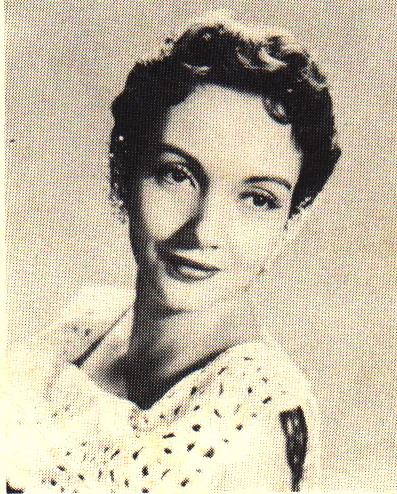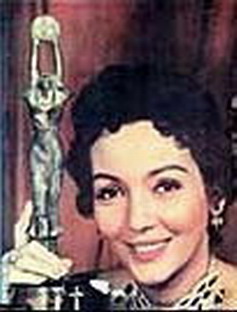Just like Carole Lombard, who never forgot that a woman’s first job is to choose the right shade of lipstick, Paraluman never forgot that a movie star’s prime obligation is to look beautiful for her public.
Paraluman, screen goddess of the 40s, was an epitome of beauty. Born Sigrid Sophia Agatha von Giese, she inherited the tinseled features of her German father and the delicate attributes of her Filipina mother.
At her prime, she was the country’s answer to Greta Garbo, with perfect bone structure, hypnotic eyes, an impenetrable gaze and a face capable of registering everything. “She’s tall, svelte, with long brown hair, maamo ang mukha”, says her only child, TV host and actress Baby O’Brien.
“She was so angelic, her film directors had to dye her hair black for chutzpah. “During shootings, nilalagyan lang siya ng foundation, konting blush-on, mascara, lipstick, ‘yun na. And her eyes, nagsasalita”.
Paraluman understood that movie fans expected to see her looking young and beautiful. So, she guarded her image as glamour queen real well.
In one court hearing where she stood as witness, she refused to tell her age. She only relented, when the judge agreed that she could whisper it to him.
She is best described by her name, Paraluman, which means “a lady of extra-ordinary beauty and grace.” The name is so complete, it required no surname, making her the first movie actress to use a single word for a screen name.
Paraluman lived up to her image. “Even at home, my Mom would always bathe, get dressed and put on make-up,” says Baby. “She would justify that, by joking, ‘Malay mo, nagkasunog, de lalabas ka, mukha kang bruha”.
The young Paraluman was a movie fan, who loved reading magazines about her favorite stars. Her interest in showbiz increased when she learned that their next-door neighbor was the big movie star, Corazon Noble.
Oftentimes, she would climb over the fence to catch glimpse of the actress.
Her curiosity yielded positive result. Noble’s younger sister, Lily, noticed their nosy neighbor and soon, they were friends.

At 17, she was recommended by Norma, another sister of Corazon, to Luis Nolasco of Filippine Films. Her first movie was “Flores de Mayo” (1940), using the screen name Mina de Gracia.
It was later changed to Paraluman by Fernando Poe Sr, who signed her as a full-pledged star in X’otic Films’ “Paraluman” (1941). This was followed by “Bayani ng Bayan” and “Puting Dambana”.
After the war, she came back to cinema as a contract star of Sampaguita Pictures. “She was a famous leading lady in romantic movies but when she made a comeback, her image was repackaged by Doc Perez,” says Baby.
“She was given character roles, playing nemesis to Gloria Romero in “Hongkong Holiday”. Sa ‘Tanikalang Apoy’(1959), lumpo naman siya.”
The maneuver paid off because in 1957, she won the Famas for her performance in “Sino Ang May Sala?”
According to Baby, after winning that award, Doc Perez congratulated her mom, and said: “Now, Paraluman, you are an actress. Not just a pretty face.“
Paraluman also pushed some boundaries. She was one of the first actresses to do a kissing scene. She also did a nude scene in the international film, “Elephant Girl” for Run Run Shaw, while in “Sarawak,” she was a sexy jungle girl who had underwater scenes.
Her cosmopolitan features also worked to her favor, and helped her land in many foreign films. In fact, Tom Selleck’s first movie, “Daughters of Satan”, also starred Paraluman. She also appeared in “Moro Witch Doctor” (1964) with Jack Mahoney, “The Losers” (1970), “Blackbird Guerilla” and “Surrender – Hell!” (1959).
Nowadays, film celebrities make personal appearances abroad to fuel interest in their movies. That practice was started by Paraluman.
With the help of her second husband, Captain Tony O’Brien, who also served as her manager, she went to Honolulu with her leading man Leopoldo Salcedo and staged a show before the screening of “Dalawang Bandila”.
Her filmography in a career that lasted for almost four decades, listed: “Mister Mo, Lover Boy Ko” (1975), “Ang Class Reunion”, “Anino ni Bathala “(1958), “Apat na Yugto ng Buhay” (1961), “Estela Mondragon” (1960), “Gigolo” (1956), “Ipinagbili Ko Ang Aking Anak” (1959), “Kuwintas ng Alaala” (1960), “Lydia” (1956), “Makasalanang Daigdig” (1961), “Pitong Pagsisisi” (1959), “Rodora” (1956), “Sonata” (1957), “Ulilang Angel” (1958), “Veronica” (1957), “Biro ng Tadhana,” “Highway 54,” “Palikero,” “Amy, Susie, and Tessie,” “Ako ang Katarungan,” “Dahil sa Isang Bulaklak,” “Lilet,” “Kahapon Lamang”, “Rosa Rossini”, “Baby Face”, “Batong Buhay” and “La Paloma” among others.
Like the reclusive Garbo, Paraluman retired from the movies, when it was time. She suffered from vertigo, which caused her to faint often.
Paraluman will always be remembered for her extra-ordinary beauty. “Ang mommy ko, mahinhin, matagal bago mag- loose ng temper. To this day, she’s still as gentle,” says Baby.
Paraluman’s distinctive blend of beauty, talent and style made her a unique presence in Filipino films, earning her high marks from a generation of pinoy filmgoers.
(For comments, send e-mail to gypsybaldovino@yahoo.com)
2 Comments
Pingback: Dunkirk, Paraluman, etc. – Jumping Jolens
Pingback: The “It Girls” of Our Lolo and Lola’s Generation